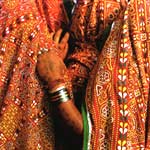|
|
What is Teej and why is it celebrated?
Festival Date
A Festive Procession of Parvati the festival of Teej celebrates the onset of the monsoon in the month of Shravana, after the long and arduous summer. The day commemorates the event of Parvati leaving the home of her parents as a bride and Shiva coming to fetch her. The festival is extremely popular among women in north India. Married women come to their parents' home to celebrate this festival. It is an occasion for them to sing, dance and make merry. Songs in praise of Parvati, whose devotion to her husband is exemplary, are popularly sung. Special swings are hung on tree branches, and the women, reveling in the transformed, verdant countryside, swing on them. They dress up as befits a married woman, adorning all the solashringara. They fast to rededicate themselves to their husband and family. It is believed that by praying to Parvati, marital bliss is bestowed upon oneself. Usually a fair is organized on this occasion. For the rural women specially, this is a time to pamper and enjoy oneself, by buying bangles, bindis, bead necklaces, getting photographs taken, and eating sumptuous dishes. After a ceremonial worship at home, an image of Parvati, clad in red and gold, borne on a palanquin is taken out in a procession, representative of her marriage procession. Several elephants, camels and dancers accompany the idol. Another form of Teej observed in Rajasthan, Uttar Pradesh, Bihar and Maharashtra is Haritalika Teej. This is a three-day festival, celebrated by women also in honor of Parvati, in the month of Bhadrapad. By praying to Parvati on these three days, unmarried girls hope to get a husband like Shiva. Married women pray to her for marital bliss. According to Hindu mythology, Parvati was in love with Shiva. Being an ascetic however, Shiva was not aware of her. Parvati performed penance on the Himalayas for many years before Shiva finally noticed her. Realizing the depth of her love and devotion, he agreed to marry her. Since then Parvati has been worshipped as Haritalika. Women and young girls maintain nirjala vrata on these three days, and keep awake all three nights. This is symbolic of the penance, which Parvati undertook to get Shiva as her husband. They offer food to Brahmins and young girls. In Maharashtra, women wear green bangles, green clothes, golden bindis and kajal to signify their luck. They distribute beautifully painted coconuts to their female relatives and friends and offer fresh fruit and green vegetables to the goddess as thanks giving. When the rituals are over, they eat a feast of jaggery and rice patolis steamed in banana leaves, a sweet made from coconut milk and rice, and mixed vegetables cooked with spices and coconut milk. Tender coconut water is the treat of this day.
View Other Festivals this Year

|
|




